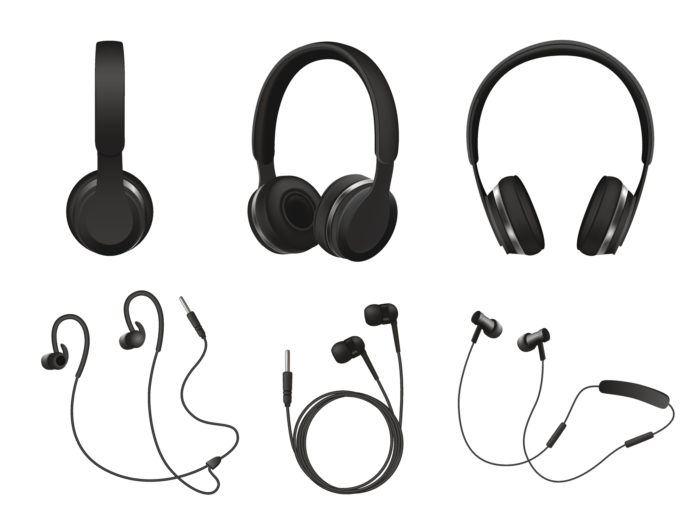Almost a third of Americans in a recent survey said they use their headphones every single day, mostly pairing them with a smartphone as their number one portable music source. But the fact is, choosing the best headphones or earbuds is more complex a decision than ever, given the wide range of options now on the market.
The way people use their headphones differs, as does the level of performance they expect out of them as per the amount they are willing to invest.
Below, we’ll give you some assistance by covering the major features and options you need to weigh. These are the decision points that, together, will steer you to your most ideal headphone choice.
Over-ear VS In-ear
There are two basic options here: over-ear (headphones proper) and in-ear (earbuds). Both have their pros and cons, and many people will prefer to own a pair of both.
Noise canceling is especially crucial for in-ear style phones, though not at all unimportant with their over-ear counterparts. To compare noise canceling earbuds side-by-side, click the link – it will show you the rundown on modern earbuds, comparing multiple key factors but with a focus on noise canceling technology.
Some dislike having anything inside their ear while they listen to music, but there are earbuds that are very comfortable to wear and some models that actually attach just behind the ear. And earbuds are less visible, more compact, and don’t pose the danger of getting accidentally knocked if you walk while wearing them (because they lack the bulk of ordinary headphones.)
Over-ear headphones, however, can sometimes offer additional features and “better sound” – but this is not at all always the case. And, they may have 360 degree swivel motion, a detachable power cord, and full collapsibility – which all help with portability and ease of use.
But as to style and comfort, it’s a very personal choice. Many recording artists and game streamers love the look and feel of over-ear sets, while commuters and vacationers tend to prefer in-ear. But it varies, and there’s no right or wrong answer here.
Wireless VS Wired
Doubtless the next big choice to make when selecting your ideal audio phones for use with a smartphone is whether or not you want to “go wireless.”
There are obvious advantages to losing the cable, and some new smartphones don’t even include a headphone jack anymore (though most do). But of course, you can always connect speakers to phone via the USB port or Lightning port, though some experts recommend against that.
By and large, wireless technology is superior and reliable. But some people don’t feel comfortable having nowhere to plug in their headphones, dislike having to worry about recharging their wireless headphones, or have had a bad experience with wireless headphone reception.
But while it’s not a bad idea to own a wired headphone as a backup, most Bluetooth wireless headphones get as good or better of reception nowadays as do their wired counterparts. And that’s great news for streaming music or movies anywhere, anytime, without disturbing your neighbor and without compromising on sound quality!
But if you go the Bluetooth route, be sure to get a high-end DAC and amp. Those two components are responsible for converting digitally streamed music into analog format so you can actually listen to it. DAC, amp, and related “codecs” that encode, compress, and decode audio data greatly affect sound quality for Bluetooth.
For Androids, look for LDAC codecs, for iPhone look for AAC, and for Qualcomm Chip phones look for aptX – to get the best possible sound quality.
Note that, in most instances, Bluetooth headphones will deliver superior sound than both your regular phone sound system or a wired headphone. But with LG V30, a dedicated and very high end in-phone sound system means that wired audio will get higher sound quality than wireless – so long as the source of the music/sound itself is high quality.
Finally, note that if you go wired, you have to check “impedance” level. An impedance level between 20 and 50 is good, but anything higher and your sound will seem low, while an impedance that’s too low will make the sound rather blasty and/or distorted.
Frequency Response
To get the greatest range of distinctly heard sounds out of your headphones, you need a good frequency response.
Frequency response is rated as a low number that stands for the lowest bass sound those particular headphones are capable of reproducing and a high number that stands for the highest treble sound the headphones can produce.
This is all measured in Hertz, and you want to make sure your headphones have a frequency response range of 5 to 35,000 Hertz or as close to that as possible. That range is the full scope of sounds that human ears are capable of hearing.
But to balance this need with affordability, you might settle for 15 to 24,000 Hertz as acceptable frequency response.
What About USB-C Headphones?
If you’re not going to go with Bluetooth wireless quite yet (if ever), then one option aside from “regular” wired headphones is USB-C headphones.
These don’t come in a huge variety right now, but what is available falls into two general classes: active and passive. Most smartphones only support one or the other kind of USB-C audio, so you probably need to choose your headphones here based whether your existing phone supports active or passive.
Androids all support active USB-C headphones (or dongles in a pinch), but there are very few smartphones out there that can use passive ones. Motorola is the main phone that will take passive. Unfortunately, most phones don’t even list if they take active/passive USB-C on the package, so you’ll need to do some research or talk to an expert if you’re buying a phone to match existing headphones.
There are certainly numerous other factors like size, color tone, comfortable padding, stylish contours, and more to consider when shopping for headphones to pair with a smartphone. But the above takes in most of the most important features to decide on, with much of the remaining decision-making having to do with more personal and aesthetic matters.










